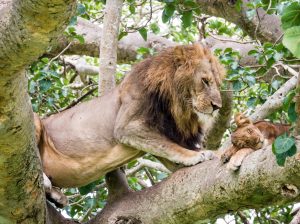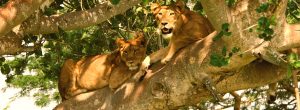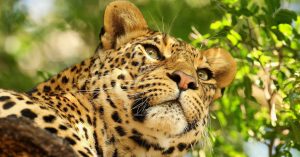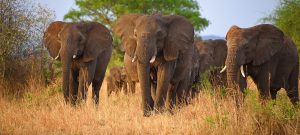Table of Contents
Best Way To Access Queen Elizabeth National Park
Here we are looking at the best way to access at Queen Elizabeth National Park Uganda. Queen Elizabeth National Park is a savannah park located in western Uganda, Kasese district and was founded in 1952 by joining together the then Kazinga reserve to lake Edward and lake George thus forming the Kazinga National Park which was later on renamed Queen Elizabeth National Park in commemoration of the visit of Queen Elizabeth II of England in Uganda. Queen Elizabeth National Park has over 90 mammal species including the four of the big fives and it’s the leading birding site in Uganda with 600 bird species.
Best Way to Access Queen Elizabeth Queen National Park which is common for its climbing lions at the Ishasha sector. A remarkable wildlife experience and a boat cruise at the Kazinga channel are a must do when you get to this wonderful park.
Queen Elizabeth National Park is located in western Uganda, shared by Bundibugyo, Bushenyi and Kasese. The park is 1978km² in size. the park includes the parts of Lake Edward and Lake George which are linked by Kazinga channel.
How to get to Queen Elizabeth National Park
Queen Elizabeth National Park is the second largest park after Murchison falls national park. It can be accessed by two means of transport such as road transport and air transportation, below is the location of Queen Elizabeth National Park. It is the same way distance from queen Elizabeth national park to Bwindi impenetrable national park.
- Road transport
Queen Elizabeth National Park can be accessed from Kampala to Queen Elizabeth National Park Kasese will take at least eight hours along a tarmac road. There are two routes from Kampala, via Mbarara to the east of the park (covers distance of 250 miles), or Fort Portal to the north (covers slightly longer at 260 miles). Most visitors choose to include stops at other parks along the way rather than driving direct from Kampala to Queens.
- By Air
Queen Elizabeth National Park can also be accessed by air from both Entebbe International Airport, the country’s international airport mainly the starting point, and the Kajjansi Airfield near Kampala.
The closest airports to Queens are Kasese, Mweya and Ishasha. Uganda’s domestic flight network offers a range of scheduled direct flights, and aircraft can also be chartered. The distance from Kampala to Queen Elizabeth National Park, the flight takes 2 to 3 hours.
Best Time to Visit Queen Elizabeth National Park
Queen Elizabeth National Park was gazetted in 1952 and its a home of over 95 mammal species including the famous four of the big five, it is one of the questions that tourists ask when planning a safari to Uganda and this blog will guide you to plan a successful safari to Queen Elizabeth National Park .Queen Elizabeth National Park is the second largest park and one of the most popular national parks in Uganda, located in the western region in four districts namely, Kasese, Kamwenge, Rukunjiri and Rubirizi.
The Best Time to Visit Queen Elizabeth National Park are divided into different months and season like Dry season, cool seasons, Hot seasons, Rainy season and Wet season as it’s considered as summer and winters in some outside countries.
Dry Seasons in Queen Elizabeth National Park
The Dry Season in Queen Elizabeth National Park is a yearly period of low rainfall, especially in the tropics. The weather in the tropics is dominated by the tropical. It’s considered as the Best Time to Visit Queen Elizabeth National Park.
The long Dry Season in Queen Elizabeth National Park it is the best weather to visit the park in western Uganda. In June, July and August and it also has the short dry season and it’s also good to visit thus it occurs from the mid-December into January ending around late February. The following are to be expected during dry season.
- Passable roads
- Little rainfall
- climbing lions
- Nature walks
- Animals looking for water sources.
- Short grass
- Birding
- Hiking trails
- Boat cruising
- Community interaction
- Chimpanzee trucking
During dry season, the vegetation is sparse which makes the locating of the wildlife easier, since the animals need the freshwater bodies for refreshing and drinking. In this season the navigation of roads takes little time and there are fewer bugs. The highest day time temperature is 30°C and the law average is 17°C.
However Hot Seasons in Queen Elizabeth National Park being the best season to visit the park, it also has many challenges thus making the tourists uncomfortable as listed below.
- Very hot
- Overcrowded
- Expensive accommodation
- High costs
Wet Seasons in Queen Elizabeth National Park
The Wet Season in Queen Elizabeth National Park begins in from March to May and August to December, the highest rains are in April, October and November though November is having the heaviest rain. It has a little Best Time to Visit Queen Elizabeth National Park. And these are to be expected during wet season in Queen Elizabeth National Park.
- Thunderstorms
- Migratory birds (birding) [Papyrus Gonolek, African Skimmers, Unique Shoebill stock]
- Viewing animals
- Beautiful nature
- Less or no costs
- Glowing pastures
- Nature walks
- Few visitors
During wet season, the environment becomes very green and shows the beautifulness of Queen Elizabeth National Park. although it’s a wet season, the prolonged rainfall makes the roads and chimpanzee tracking trails slippery, rare unique tree climbing lions among others. Therefore, Queen Elizabeth National Park’s activities can be done throughout the year but mostly in the dry season.
Lodges in Queen Elizabeth National Park
Accommodation in queen Elizabeth national park is one thing you shouldn’t worry about we you visit Queen Elizabeth National Park. There different accommodation categories ranging from budget, midrange and luxury. below are some of the examples.
- Kyambura Gorge Lodge.
This lodge definitely exceeds all the expectations and is perfect for visitors that want a mix of luxury lodge stay whilst doing exiting activities. The Kyambura Gorge lodge sits outside the Queen Elizabeth National Park and you can trek to see the family of habituated chimpanzees from the lodge.
The lodge also has different kind of rooms like an open-plan bedroom with a day bed, the suite bedrooms are also huge.
- Mweya Safari Lodge
This is also one of the luxury lodges in Queen Elizabeth National Park. It is surrounded by the magical Rwenzori mountains known as mountains of the moon and it is located on the peninsula within the heart of the Queen Elizabeth National Park.
- Parkview Safari Lodge.
This is a mid-range lodge which combines local and modern materials, opening to the wilderness beyond, it is located shirts of Queen Elizabeth National Park.
- Banda Accommodation
These are mid-range accommodations. They are within the bushes of Queen Elizabeth National Park and are most suitable for nature loves.
- Katara Lodge
Everything on this lodge was hand crafted from the wood flour up to the grass thatched roof and offers accommodation in eight luxurious cottages on a beautiful stretch of hills overlooking the open savanna in a serene and relaxing atmosphere.
- Elephant Plains Lodge
This lodge is a new branded lodge located on the edge of Queen Elizabeth National Park offering spacious luxurious en-suit guest accommodation with breath taking views of Queen Elizabeth National Park. This lodge offers 10 spacious rooms with en-suit facilities private veranda.
- Kazinga channel view resort
This resort is a fantastic budget stay, many common animals can be observed for drinking water In front of the resort. On this Kazinga channel view resort’s perks are to consistent electricity, charging electronics and hot water for showers.
- Simba Safari Camp
After the showers of lake Kikarango, the camp is located on another gate. This is especially for travelers who don’t mind sharing and it’s a budget accommodation. It is constructed as a dormitory and it’s the cheapest accommodation and camping is also possible.
Things to do in Queen Elizabeth National Park
There are many activities to carry out during a safari tour in Queen Elizabeth National Park and include.
- Game Drives
Game drives is one of the things to do when you get to Queen Elizabeth National Park. Game drives are conducted both in the morning and evening hours. This is an activity you can engage in and during the game drive, you will see different animals like the elephants, antelopes among others.
During the month of January to February and June to September, Queen Elizabeth National Park experiences its dry season and grass is short and dry grass thus it makes the clear view of seeing Common birds include swamp flycatcher, pels fishing owl, shoe bill, collared pratincole, palm nut vulture the black bee eaters, majestic African fish eagle and cormorants,
Around the month of November to April, the park receives migratory birds, and these are believed to come from Europe during winter in search for food.
- Lion Tracking
Lion tracking is the most interesting activity one would like to carry out which contains research and other unique facts. It’s mainly done at Kasenyi plains, budget and you can get closer to the African lions though it is carried out by the limited number of people to prevent interference. Thus, they are the most attractions in Queen Elizabeth National Park.


- Chimpanzee Trekking
This activity is done in the northern part of the park and at a place called Kyambura Gorge which is known as the home of chimpanzees, and they are under the rain forest which protect them from sunshine.
Animals in Queen Elizabeth National Park
Queen Elizabeth National is most famous for its diverse mammal and bird species in Uganda. With about 95 mammal species and over 600 bird species, its one destination that will leave you fulfilled with adventure as most game activities are crowned by a boat cruise at the famous Kazinga Channel. It has the four of the big five in the world. This is the list of animals in national park.
- Lions in Queen Elizabeth National Park
Lions are carnivores’ animals and belong to the cat family. These are largest animals in the cat family and are one of the big five. Lions’ gestation period is about 108 days. These do not chew their food; they have small incisors at the front of their mouth used to grip the meat whilst their sharp carnassial teeth in back of their mouth tear it into chunks and then they swallow.
- Leopards
They are the smallest of the big cat family and are vulnerable and belong to Felidae family. In Queen Elizabeth, leopards have sharp teeth, strong jaws, powerful bodies, they are notoriously shy, skilled climbers, eat prey, and belong to the Felidae family.
They have a gestation period of 90-105 days, and they grow up to 6.2 feet, their tail adds more 25-36 inches. A male leopard usually weighs around 36-75 kg, and a female leopard typically weighs 21-60 kg. Leopards are nocturnal i.e., they are active during night, and they are solitary creatures.

- African buffalo
The African buffalo is a large sub-Saharan African bovine, and they live in large herds on savanna and smaller herds in forested areas. An interesting behavior observed in African buffaloes is seemingly altruistic partnership and belong to Bovidae family. The mud baths are very important buffalos because the mud cover in the skin, regulates body temperature and repels ecto-parasites and flies.
- African elephants
are the world’s largest land animals, and they are among the big five. They have six sets of molar teeth and when the last set is lost, die. Elephants spend about 16 hours a day eating and can consume up to 300 kilograms of food. African Elephants when you visit the park, and they are among the big five. They have six sets of molar teeth and when the last set is lost, they are unable to eat and eventually die. Gestation period is almost two years or less than.

- Antelopes
Antelopes in Queen Elizabeth National Park are classified in different types like reedbuck, sitatunga, Topi, Uganda Kob, duiker, bushbuck, waterbuck, etc. the Uganda Kobs are the most common and their gestation period is 7.5 to 9 months.

- Spotted hyenas
The spotted hyena is also called the laughing hyena, it’s the most common large carnivore in Africa and their gestation period is 110 days. They are four types of species striped hyena (hyaena hyaena). The brown hyena (Para hyaena brunnea), the spotted hyena (Crocuta Crocuta) and the aardwolf (Proteles cristate).
Spotted hyenas are skilled hunter as well as scavengers, their sound of laughing is a sound made to inform the group members to a source of food and noise can be heard up to three miles away.
- Warthogs
A warthog is a wild member of the pig family found in savanna grassland and savanna woodland. Their scientific name is Phacochoerus, always the common warthogs do not dig their burrows, males are always solitary in their wild and females make family group or sounders and their young ones. Common warthogs are light grey to brown color, they have three pairs of ‘warts’ are along their face.
- Nile crocodiles
The Nile crocodiles are the large crocodilian native to freshwater habitats in Africa. It is considered in 26 countries, it is the largest water predator in Africa, they are the one of the most dangerous species of crocodile and is responsible for hundreds of human deaths every year.
Female sexual maturity occurs when they reach 2.2-3 m (7ft 3in to 9ft 10in) and for the males’ sexual maturity 0ccurs when they are about 3.3m (10ft) long and mass of 155kg. Sexual maturity is obtained from 12-16 years of age.
- Chimpanzees
Chimpanzees are also found in Queen Elizabeth National Park, they share 98.8%-99% of the human DNA showing that they are the first cousins of human. There are habituated and non-habituated chimpanzees in Queen Elizabeth National Park. They are mainly tracked in Kyambura Gorge also known as the valley of Apes. They belong to Hominidae family.
Their gestation period takes 8 months, and they give birth to one individual, twins are very rare.
Entrance fee for Queen Elizabeth National Park
The entrance fee is given at any main gate of entering Queen Elizabeth National Park. But before entering, the foreign residents are of Uganda are supposed to present their valid on year working permits, East African citizens present their national identity cards, and the foreigners are required to present their passports for verification.
- USD40 for the foreigners
- USD30 for foreign residents of Uganda
- UGX20,000 for East African community citizens.
- UGX100,000 for a safari guide annual park entrance.
- USD30 foreign residents’ motorcycles
- UGX10,000 for East African citizens’ motorcycles.
- UGX50,000 for a school bus
NOTE: The entry fee is not levied on children below 15 years. The park entry fee is only for a single day (24 Hours).
Frequently asked questions
Are the gorillas in Queen Elizabeth National Park?
No, the population of gorillas in Queen Elizabeth National
How does it cost to Enter Queen Elizabeth National Park?
The entrance fee in Queen Elizabeth National Park is as below accordingly.
- USD40 for the foreigners
- USD30 for foreign residents of Uganda
- UGX20,000 for East African community citizens.
- UGX100,000 for a safari guide annual park entrance.
- USD30 foreign residents’ motorcycles
- UGX10,000 for East African citizens’ motorcycles.
- UGX50,000 for a school bus
NOTE: The entry fee is not levied on children below 15 years. The park entry fee is only for a single day (24 Hours).
How much is the game drive at Queen Elizabeth National Park?
- USD40 per foreign nonresidents
- USD30 per foreign residents
- UGX20,000 per East African citizens
Conclusion
Queen Elizabeth National Park is the second largest park after Murchison falls national park. And all activities explained above can be carried out throughout the year. Enjoy your safari or vacation in Queen Elizabeth National Park any time.
